
Atlas F1 Technical Writer
The Italian Grand Prix marks the end of the European racing season, and with competition for best of the rest hotting up the teams brought out their low downforce cars for the fastest circuit on the calendar. Craig Scarborough analyses the changes the teams showcased in Monza
To meet the low drag requirements teams flatten their wings to the lowest possible setting and discard a lot of the aerodynamic trivia around the car, such as shelf or mid wings, flip up details and cooling chimneys. Offsetting the demand for low drag are the larger brake ducts to cool the brakes for the big stops from 360 kmph into low speed chicanes.
Despite the demands on engine output the high speed improves the throughput of air in the sidepods, increasing the efficiency of the cooling system. In addition the chimneys increase drag, while Monza demands minimum drag to improve speed on the long straights, which lead most teams to remove some of the extra aerodynamic paraphernalia, such as mid wings and flip ups.
Monza punishes bigger wings with slower laptimes, despite the improved grip through the chicanes. Most teams went light on downforce for qualifying, despite the threat of rain in the race. A few teams went for more downforce, notably on Jenson Button and Rubens Barrichello's cars, while Renault was the leanest on wings. With the rain arriving before the race, leaving the track damp, the teams were faced with a difficult choice of tyres; they were allowed to start on wet weather tyres (i.e. full wets or intermediates), although only a few drivers opted for this, mainly Bridgestone runners, which are more sensitive to damp tracks than the Michelins. In the damp opening lap the intermediates on Rubens car worked well, but lost their advantage after only five laps.
Under the old qualifying rules Monza allowed refueling before the race, leading to a one stop strategy, as the high speed/low laptimes penalised frequent stops. This year most teams opted for two stops, although David Coulthard stopped after the warm up lap and effectively returned to this strategy, filling his tanks before the start. Meanwhile Barrichello, who had to make an extra stop for slick tyres, switched to a three stop race.
Team by Team
Ferrari
Aside from reduced wings, Ferrari continued to run a familiar F2004. In testing the team raised eyebrows with a fairing covering the full length of the nose/chassis, which was on the car when Michael Schumacher had his accident. The purpose of the fairing has been debated, and as it did not appear at the Monza race its purpose remains unclear - it could either be a fairing to reduce drag on Monza's long straights which was not of enough benefit to bring to the race weekend, or a trial for the 2005 car which could have a higher nose to accommodate the raised front wing.
Friday saw the usual fastest times in the morning session, only to be usurped by McLaren as their programme changed to long run evaluations of the tyres and new engine specification in the afternoon. After setting lowly times in the first qualifying session, Barrichello set the pole lap with a car that later proved to be partly set up for a wet race. While Schumacher had a full dry set up he made a mistake in sector three, costing him several tenths.
In the race Schumacher started with slicks over Barrichello's gamble on intermediates – Ferrari, running Bridgestone, knew there would be an advantage on the partly wet track over the Michelin runners. Barrichello made a very slow paced warm up lap, choosing not to zigzag to warm his tyres too much in order to preserve the heavily grooved intermediates. Despite the optimism of Barrichello opening a lead in the first few laps, Schumacher's spin in the second chicane and the fight back of the Michelin runners by lap 5 put the team under pressure.
By monitoring Schumacher's pace over the latter of the first five laps, it was decided that Barrichello could be put on a three stop strategy to allow him to run faster; he pitted for just 6.9 seconds and rejoined on slick tyres. As the race progressed, and the track rubbered in after being cleaned by the rain, the Bridgestone slicks came into their own, allowing both drivers to recover from their initial problems, with Barrichello coming out in first place after the last round of pit stops.
Williams
Friday saw a normal programme for Williams, assessing tyres and the latest step in the engines development; this was cut short when Antonio Pizzonia had a major crash caused by a brake disc failure. The car sustained heavy damage, but fortunately the engine did not require replacement. A solid pre-qualifying session was followed by an encouraging second session. Pizzonia had a poorer second lap, while Juan Pablo Montoya was able to post P2 despite several errors around the lap.
The race started badly for the team, with Montoya losing one place to a Renault and Pizzonia being hit and spinning in the chicane. Both drivers fought on, with Montoya threatening the lead for the first two stints until engine mapping problems slowed him in the last stint to push him back to fifth at the finish, while Pizzonia had another battling race and, with reliability, he was able to finish seventh after failing to pass David Coulthard.
McLaren
Friday saw Kimi Raikkonen top the times in the afternoon, albeit not totally happy with his grip levels, whereas Coulthard was back in tenth. Qualifying saw Raikkonen fall back on both pace and, with an error into the last turn, Coulthard remained in tenth.
Before the start of the race Coulthard gambled on intermediate Michelins, but chose to pit after the formation lap as the track had dried enough to not warrant inters. He pitted as the grid was formed and as soon as the lights changed he refueled and fitted new slick tyres, in preparation for a one stop race, not stopping again until the mid point in the race. Raikkonen had a more competitive start, but by lap 2 had the team monitoring a water leak; losing water pressure in the engine, he pitted to retire in a cloud of steam before the first pit stops. Coulthard soldiered on and, despite being hit from behind by Pizzonia, finished in sixth.
Renault
In qualifying Alonso ran lighter on fuel and wing, setting to post a remarkable fourth, while Trulli, who was still unhappy with the car, went for a more conservative strategy. In the race the usual lightning starts were made, and Alonso soon led the race, while Trulli was struggling on the green track washed clean by the storm. In the later stages Alonso was being pressured by the Ferraris, and this lead to an error over the kerbs and a spin. Unable to rejoin the race, as he was beached on the kerb, he had to retire. Trulli found more grip as the race progressed but was already too far behind to score points.
BAR
A clean Friday, and no protests from the FIA or other teams for the FTT system, lead to a good qualifying session, albeit with Button being caught out by snap oversteer, slowing his second timed lap. For the race Button pressured for the lead, gaining it in the final stint, while Takuma Sato had a bad exit to the first chicane at the start and later ran over the kerbs, violently losing some bodywork. The final result of third and fourth was just reward for their pace and reliability. But the good result on a circuit needing heavy braking will only be seen as potential reason to protest the FTT system.
Sauber
Sauber tried struts to reinforce their winglets, but removed them soon after Friday sessions started. Struggling with their Bridgestones on the dirty track on Friday was their only real problem. With heavy race fuel loads both drivers made errors on their qualifying laps, pushing them back down the order. In the race Felipe Massa started on intermediates and ran some excellent opening laps, getting up to sixth before stopping for slicks; he then hit Nick Heidfeld and had to pit again for a new nose. Fisichella ran a long stint strategy and suffered on the green track until the later stages when he was chasing the Coulthard/Pizzonia tussle.
Jaguar
With only simple revisions to the R5 for Monza, refined in the test preceding the race, the team ran a Friday session aimed not at laptimes but race preparation. This was reflected in the better qualifying times on Saturday. In the race both drivers suffered understeer and their pit stops often involved an adjustment to the front wing flap.
Toyota
Jordan
Minardi
With low drag wings, but with all the usual aerodynamic add-ons, Minardi were always going to struggle with the old spec Cosworth engine. Friday went cleanly, but Saturday morning saw Zsolt Baumgartner hit by a spinning Pantano, writing off the chassis.
Qualifying saw the usual back row times, and the team decided to switch the engines in parc ferme to ensure power and reliability in the race. With their set up aimed towards a wet race Gianmaria Bruni made a good start, but at his second stop the fuel hose leaked some fuel, leading to a fire. Although the fire was put out rapidly Bruni inhaled some fumes and had to retire for medical treatment from the Toyota doctor. Baumgartner had a cleaner race to post a finish in fifteenth.
Monza, another of the classic circuits, follows on from Spa, and demands a completely different type of performance from the car. Its long straights dominate the track, with a car's set up focused on the 1250 metre straight rather than the fast turns or fussy chicanes. Low drag is the key set up criteria, along with maximum power form the engine. The long straight sees the cars change up into seventh gear in less than seven seconds, and keep that gear for a further seven seconds. Monza doesn't have the longest straight in Formula One, but the cars do have the throttle open longer, and for more of the lap, than any other circuit.
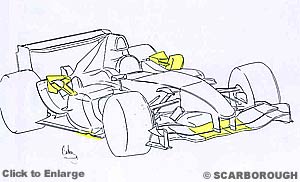 Williams once again ran the conventional nose, this time allied to a new front wing with a flatter central section. For Monza the endplate was revised, with a simplified format without any flip ups, and briefly ran a version without the wavy footplate. The rear wing was also the familiar Williams version, with a complex wing shape and serrated gurney flap all aimed at reducing drag, as was the new shaped notch behind the flap. Williams also brought the revised chimney winglets seen in testing; the larger winglet intersects with the chimney, sporting an endplate on the outside of the wing.
Williams once again ran the conventional nose, this time allied to a new front wing with a flatter central section. For Monza the endplate was revised, with a simplified format without any flip ups, and briefly ran a version without the wavy footplate. The rear wing was also the familiar Williams version, with a complex wing shape and serrated gurney flap all aimed at reducing drag, as was the new shaped notch behind the flap. Williams also brought the revised chimney winglets seen in testing; the larger winglet intersects with the chimney, sporting an endplate on the outside of the wing.
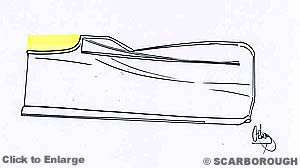 After much testing, the team's new wider nose appeared at a race weekend for the first time. As previously described, the nose used a much wider, less drooped shape, allied to a new front wing with a flatter central chord to the curved version raced for most of the year. The endplates were revised for Monza, with a small notch cut out of the endplate behind the flap.
After much testing, the team's new wider nose appeared at a race weekend for the first time. As previously described, the nose used a much wider, less drooped shape, allied to a new front wing with a flatter central chord to the curved version raced for most of the year. The endplates were revised for Monza, with a small notch cut out of the endplate behind the flap.
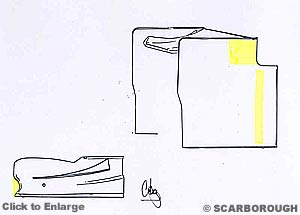 Renault ran notably less wing than anyone bar Minardi, and also produced revised endplates for both the front and rear wings. At the front the vertical leading edge profile was cut back below the wing, while the rear wing went without the complex mounts for the flap. The team ran a simplified Friday programme after the testing preceding the race. Jarno Trulli, in a newly built chassis, was still unhappy with the balance, as was Fernando Alonso, albeit to a lesser extent.
Renault ran notably less wing than anyone bar Minardi, and also produced revised endplates for both the front and rear wings. At the front the vertical leading edge profile was cut back below the wing, while the rear wing went without the complex mounts for the flap. The team ran a simplified Friday programme after the testing preceding the race. Jarno Trulli, in a newly built chassis, was still unhappy with the balance, as was Fernando Alonso, albeit to a lesser extent.
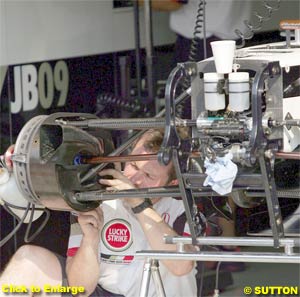 Largely unaltered aerodynamically, BAR sported a revision to its linked brake system, Dubbed FTT (front torque transfer) by most observers. While the FIA ruled the original design of the system was illegal, the revised version brought to Monza was unprotested by other teams and uncommented upon by Jo Bauer (FIA technical delegate) in his reports to the race stewards. How BAR has proven the system to be legal and still gained some form of braking advantage is secret. One other development to the BAR on the braking front has been the additional on the donut fairing outboard of the front brake discs; these both improve aerodynamics and reduce the oxidisation of the brake disc surface when running at high temperatures.
Largely unaltered aerodynamically, BAR sported a revision to its linked brake system, Dubbed FTT (front torque transfer) by most observers. While the FIA ruled the original design of the system was illegal, the revised version brought to Monza was unprotested by other teams and uncommented upon by Jo Bauer (FIA technical delegate) in his reports to the race stewards. How BAR has proven the system to be legal and still gained some form of braking advantage is secret. One other development to the BAR on the braking front has been the additional on the donut fairing outboard of the front brake discs; these both improve aerodynamics and reduce the oxidisation of the brake disc surface when running at high temperatures.
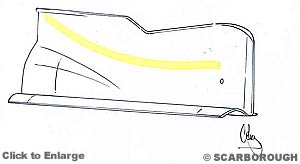 The team ran without the flip up on the front wing endplate throughout the weekend, as well as low downforce wing levels. Friday saw a vibration problem for Olivier Panis that was not cured in either session. A gearbox replacement was carried for Panis before qualifying, and both drivers put in good laps with heavier fuel loads. Panis caused some of the problems in the first chicane by hitting Pizzonia, leading to his own retirement. Ricardo Zonta struggled with grip right from the start, and the car never regained the same level of grip as expected when the track rubbered in.
The team ran without the flip up on the front wing endplate throughout the weekend, as well as low downforce wing levels. Friday saw a vibration problem for Olivier Panis that was not cured in either session. A gearbox replacement was carried for Panis before qualifying, and both drivers put in good laps with heavier fuel loads. Panis caused some of the problems in the first chicane by hitting Pizzonia, leading to his own retirement. Ricardo Zonta struggled with grip right from the start, and the car never regained the same level of grip as expected when the track rubbered in.
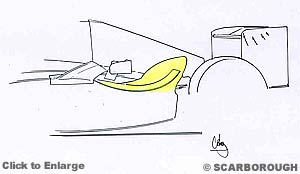 Jordan simplified their aero set up with front wing endplates, without the wavy footplate, and removed the winglet from the flip up ahead of the rear wheels. Their weekend started badly with Heidfeld's car stopping on the circuit; his problems were to last all weekend. With the engine changed overnight, a gearbox problem then occurred before qualifying, forcing him into the spare chassis. In the race Giorgio Pantano spun out, while Heidfeld had some damage inflicted by Massa early in the race which the team sorted out, allowing him to finish the race.
Jordan simplified their aero set up with front wing endplates, without the wavy footplate, and removed the winglet from the flip up ahead of the rear wheels. Their weekend started badly with Heidfeld's car stopping on the circuit; his problems were to last all weekend. With the engine changed overnight, a gearbox problem then occurred before qualifying, forcing him into the spare chassis. In the race Giorgio Pantano spun out, while Heidfeld had some damage inflicted by Massa early in the race which the team sorted out, allowing him to finish the race.
|
Contact the Author Contact the Editor |
Please Contact Us for permission to republish this or any other material from Atlas F1.
|
Volume 10, Issue 37
Atlas F1 Exclusive
Interview with Martin Whitmarsh
Interview with Norbert Haug
The Woking Timeline
Bjorn Wirdheim: Going Places
Ann Bradshaw: Point of View
GP Review
2004 Italian GP Review
Technical Review: Italy
The Good Old Days
The Frantic Quarter
Stats
Qualifying Differentials
SuperStats
Charts Centre
Columns
Season Strokes
On the Road
Elsewhere in Racing
The Weekly Grapevine
> Homepage |